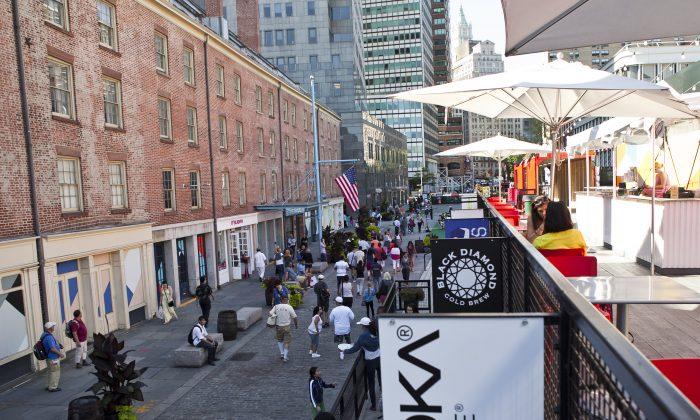NEW YORK—Imagine Lower Manhattan’s East River waterfront full of schooners and sailboats, low-rise brick buildings, cobblestone streets, and bustling maritime trade. This was New York Harbor in its heyday, but it is now reduced to a single island area called South Street Seaport.
The Seaport is a special historic district owned by the city just south of the Brooklyn Bridge. It runs from east of Pearl Street to Piers 15, 16, and 17, and abuts the financial district.
Changes that have already happened in the area, as well as potential future development, has preservationists and community members troubled.
Numerous public meetings have left them frustrated and worried about the details not yet disclosed by the Seaport’s developer.
The developer, Texas-based The Howard Hughes Corporation (HHC), under the moniker SEE/CHANGE, has the Seaport awash in corporate branding. It has added retail stores and pop-up food booths around the Fulton Market Building, which has been closed since Hurricane Sandy. Private HHC security guards patrol the area.
During the course of more than two months, the Epoch Times attended several public meetings, and interviewed nearly a dozen people representing differing interests.
Article Continues after the discussion. Vote and comment
[tok id=256e6e88f1637ee51e1a57a102cae9c partner=1966]
Lease Options
Peter Stanford was one of the key preservationists who saved the area from destruction in 1967 when the waterfront was being systematically demolished and redeveloped. He said that the lease that was renegotiated in June 2013 is “intolerable.”
“They [HHC] grab for money of any kind and have reduced the Seaport to a laughingstock,” Stanford said.
One of the provisions of the lease that has people worried the most is the option to develop two buildings, the Tin Building and the New Market Building.
“The public was not made privy to the full plan,” said Robert LaValva, another supporter of preserving the Seaport’s unique character. LaValva has operated New Amsterdam Market in front of the dilapidated New Market Building on South Street for several years.
One community goal has been to get landmark status for the New Market Building, which was once home to the famed Fulton Fish Market dating back to the 1930s. Last month the Landmarks Preservation Commission denied the request.
The building sits just outside the recently rezoned historic district, and thus has no protection from demolition and development. The Tin Building does have historic status and is within the historic district.
Though the land-marking decision can be appealed, there’s a prevailing concern that the developer will follow its current project at Pier 17 with a high-rise luxury hotel and a residential mixed-use building at the New Market Building and the Tin Building. The company holds the lease option to develop both.
And there is good reason to believe that is exactly what is happening.
HHC outlined detailed plans for developing the area in a 2011 Letter of Intent to the New York City Economic Development Corporation (EDC). In August 2013 HHC exercised its lease options on the two lots and submitted plans to the EDC.
Undisclosed Plans
So far, the contents of those plans are being kept from the public.
At a Sept. 17 Community Board 1 meeting, HHC’s representative declined to disclose any details of the proposed project. According to the meeting agenda, corporation representatives were to give an update on work at the Seaport. Few specifics were offered, however.
“There’s continued dialogue,” said Chris Curry, senior executive vice president of development for HHC. “Nothing is going to happen without everyone looking at it.”
HHC is “not even close” to the ULURP process (Uniform Land Use Review Procedure), Curry added.
During the review, the public has at least two chances for comment over the course of a year, and the clock doesn’t start ticking until the plans have been given to the City Planning Commission and certified complete.
Curry did confirm that the plans are proposals for the Tin Building and the New Market Building. Curry said they were with the EDC and would be available to the public “about mid-October.”
The EDC refused to release the documents to the Epoch Times, as did HHC in follow-up requests.
A representative for Council member Margaret Chin’s office and members of Community Board 1 said they have also been unable to obtain the documents. Chin’s office said they expect to get them “sometime in the next couple of weeks.”
“When it comes to commercial operations like these … the [lease] options are generally considered proprietary,” said Matt Viggiano, director of land use and planning for Chin’s office.
HHC has said repeatedly that any proposed plans are not final. They have also said that there isn’t much friction with the public over the process.
“It’s not as tense as you might think,” said Phillip St. Pierre, general manager for HHC by phone on Sept. 19. “We don’t want to stand in front of people and make promises [we don’t keep].”
St. Pierre’s added that it “won’t be much longer” until proposed plans for the two sites are made public.
New Amsterdam Market’s LaValva thinks there should be more public input and a community-based master plan.
“This is not a legal battle,” said LaValva. “It’s more of a moral battle, a civic battle.”




